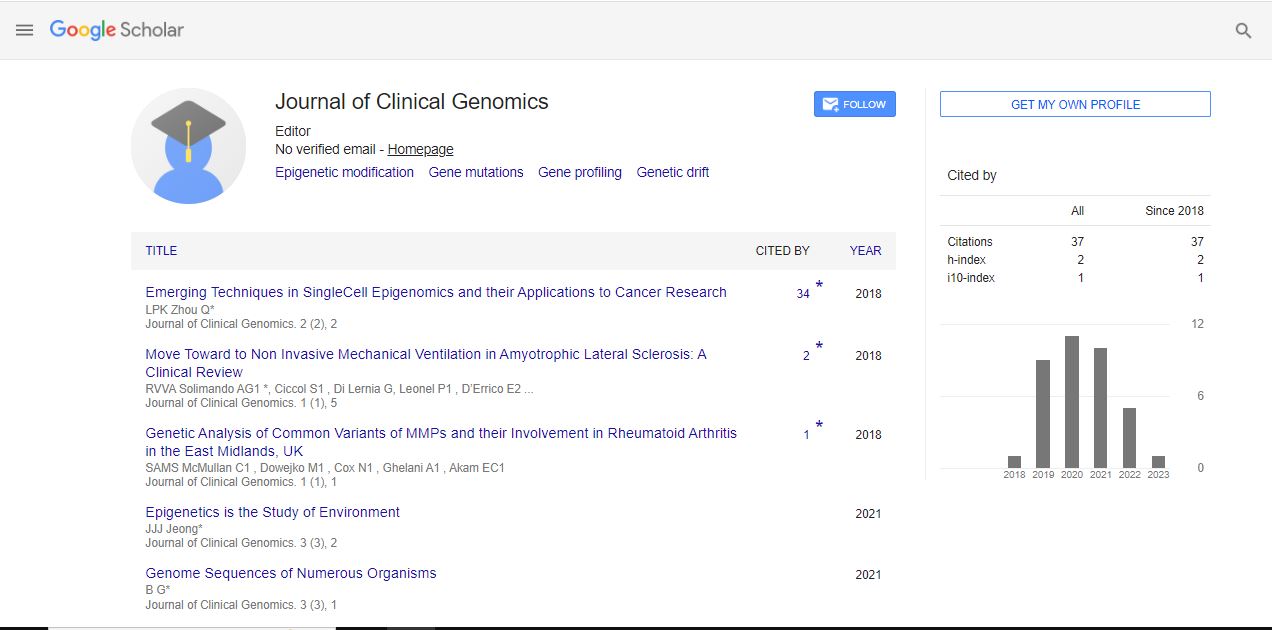Perspective, J Chromatography Res Vol: 6 Issue: 4
Advancements in Pharmacokinetic Studies through Hyphenated Chromatography Techniques
Sérgio Rugene*
1Institute for Biotechnology and Bioengineering, University of Minho, Braga, Portugal
*Corresponding Author: Sérgio Rugene,
Institute for Biotechnology and
University Bioengineering, of Minho, Braga, Portugal
E-mail: Rugenes8@unom.pl
Received date: 27 November, 2023, Manuscript No. JCGR-24-123801;
Editor assigned date: 29 November, 2023, PreQC No. JCGR-24-123801 (PQ);
Reviewed date: 14 December, 2023, QC No. JCGR-24-123801;
Revised date: 21 December, 2023, Manuscript No. JCGR-24-123801(R);
Published date: 28 December, 2023, DOI: 10.36648/JCGR.1000079.
Citation: Rugene SR (2023) Advancements in Pharmacokinetic Studies through Hyphenated Chromatography Techniques. J Chromatography Res 6:4.
Description
Pharmacokinetic studies are crucial in understanding the fate of drugs within the human body, encompassing Absorption, Distribution, Metabolism, and Excretion (ADME) processes. These studies are fundamental for optimizing drug dosage regimens, ensuring therapeutic efficacy, and minimizing adverse effects. Hyphenated chromatography techniques have revolutionized pharmacokinetic research by providing enhanced sensitivity, selectivity, and efficiency in the analysis of drugs and their metabolites. This essay explores the principles, applications, and advancements in pharmacokinetic studies achieved through the integration of hyphenated chromatography techniques.
Principles of pharmacokinetic studies
Pharmacokinetics involves the quantitative analysis of the timedependent concentration of drugs and their metabolites in biological matrices. The four main processes of pharmacokinetics are:
Absorption: The process by which a drug enters the bloodstream from its site of administration (e.g., oral, intravenous, subcutaneous).
Distribution: The dispersion of a drug throughout the body, including tissues and organs, after absorption.
Metabolism: The enzymatic transformation of a drug into metabolites, usually occurring in the liver.
Excretion: The elimination of drugs and their metabolites from the body, primarily through urine and feces.
Chromatography in pharmacokinetic studies
Chromatography, a versatile separation technique, is a cornerstone in pharmacokinetic studies. It allows for the separation of complex mixtures into individual components, facilitating the quantitative determination of drug concentrations in biological samples. The integration of chromatography with various detection methods enhances the precision and sensitivity of drug quantification. Hyphenated chromatography techniques involve coupling chromatographic separation methods with advanced detection techniques, providing a comprehensive approach to pharmacokinetic studies. The synergy between chromatography and various detectors or mass spectrometers has led to significant advancements in sensitivity, selectivity, and analytical efficiency.
Liquid Chromatography-Mass Spectrometry (LC-MS) combines the high-resolution separation capabilities of liquid chromatography with the mass analysis capabilities of mass spectrometry. After separation, the eluted compounds are ionized, and their mass-tocharge ratio is measured. LC-MS is widely used in pharmacokinetic studies due to its versatility in analyzing a broad range of compounds. It is particularly valuable for drugs with complex metabolic pathways and low concentrations in biological fluids.
Gas Chromatography-Mass Spectrometry (GC-MS) pairs gas chromatography with mass spectrometry, making it suitable for volatile and semi-volatile compounds. The sample is vaporized, separated in the GC column, and then ionized and detected by mass spectrometry. GC-MS is employed for pharmacokinetic studies of volatile drugs and their metabolites. It is especially useful for drugs that undergo extensive metabolism and produce volatile derivatives.
Liquid Chromatography-Tandem Mass Spectrometry (LC-MS/MS) combines liquid chromatography with tandem mass spectrometry, allowing for increased sensitivity and specificity. After initial mass spectrometric analysis, selected ions are fragmented, providing additional structural information. LC-MS/MS is extensively used in pharmacokinetic studies for its exceptional sensitivity and ability to quantify multiple compounds simultaneously. It is particularly valuable in the analysis of low-abundance metabolites.
Liquid Chromatography-UV/Visible Spectroscopy (LC-UV/Vis) combines liquid chromatography with UV/visible spectroscopy, relying on the absorption of UV or visible light by the analytes. This technique is straightforward and often employed for routine pharmacokinetic analyses. LC-UV/Vis is suitable for the analysis of drugs with chromophores or conjugated systems. While not as selective as mass spectrometry, it remains a cost-effective option for certain pharmacokinetic studies.
Liquid Chromatography-Nuclear Magnetic Resonance (LC-NMR) integrates liquid chromatography with nuclear magnetic resonance spectroscopy. The eluted compounds from the chromatographic column are subjected to NMR analysis, providing detailed structural information. LC-NMR is utilized when both separation and structural elucidation are crucial. It is especially valuable for identifying unknown metabolites in pharmacokinetic studies.
Solid-Phase Microextraction (SPME)-Gas Chromatography-Mass Spectrometry (GC-MS) combines solid-phase microextraction with gas chromatography-mass spectrometry. The sample is exposed to a coated fiber, which extracts analytes. The fiber is then introduced into the GC-MS system for separation and detection. SPME-GC-MS is employed for the analysis of volatile and semi-volatile compounds in pharmacokinetic studies. It simplifies sample preparation and enhances sensitivity.
The integration of advanced detectors, such as mass spectrometers, in hyphenated chromatography techniques has significantly improved sensitivity and selectivity. This is particularly advantageous for pharmacokinetic studies involving low drug concentrations and complex biological matrices. Hyphenated chromatography techniques allow for high-throughput analysis, enabling the simultaneous determination of multiple analytes. This is essential in pharmacokinetic studies where efficiency and the ability to analyze numerous samples are critical.
 Spanish
Spanish  Chinese
Chinese  Russian
Russian  German
German  French
French  Japanese
Japanese  Portuguese
Portuguese  Hindi
Hindi 